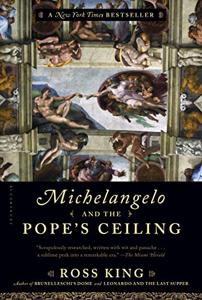
Want to learn the ideas in Michelangelo and the Pope’s Ceiling better than ever? Read the world’s #1 book summary of Michelangelo and the Pope’s Ceiling by Ross King here.
Read a brief 1-Page Summary or watch video summaries curated by our expert team. Note: this book guide is not affiliated with or endorsed by the publisher or author, and we always encourage you to purchase and read the full book.
Video Summaries of Michelangelo and the Pope’s Ceiling
We’ve scoured the Internet for the very best videos on Michelangelo and the Pope’s Ceiling, from high-quality videos summaries to interviews or commentary by Ross King.
1-Page Summary of Michelangelo and the Pope’s Ceiling
Overall Summary
Ross King’s book, Michelangelo and the Pope’s Ceiling, begins in 1508 when Michelangelo was commissioned to paint the ceiling of a newly renovated chapel. He had been commissioned by Pope Julius II who had recently become head of the Catholic Church.
King’s book tells the story of Michelangelo and how he created his masterpiece, The Sistine Chapel. It doesn’t dramatize the events but instead provides an account of Michelangelo’s work on it. King describes his assistants who helped him with the project as well as his rivalry with Raphael. He even goes into detail about what they ate for breakfast during that time period!
King’s book isn’t just about the technical aspects of such a large undertaking. He also delves into the personalities behind it, including Pope Julius II who orders that the old ceiling be stripped and replaced with new frescos. The Pope wants to add some flair to his papacy by having biblical scenes painted on the ceiling; he hires Paride de’ Grassi to find an artist for this job.
De’Grassi’s choice of Michelangelo to paint the ceiling of the Sistine Chapel ruffles Pope Julius II’s feathers. He has several reasons for his discontent, including Michelangelo’s inexperience with painting and their argument over plans for a tomb. De’Grassi is adamant about using Michelangelo, but in the four years it takes them to complete the project they have many arguments. When it is finished, everyone is surprised by how great it looks.
This passage is a historical narrative about Michelangelo’s frescoes in the Sistine Chapel. However, there are certain facts that are important for understanding this story. For example, Michelangelo had to work quickly because of the materials he used on his paintings. He also claimed to have worked very fast and finished some portions of the ceiling in just days instead of weeks or months as would normally be required.
The author does a great job of describing the intricate details of creating art, as well as its historical significance. The book is not just about how Michelangelo created his masterpiece on the ceiling of the Sistine Chapel, but also about all the other aspects that went into making it happen. There’s an entire cast of characters involved in planning and executing this project, including those who manufactured pigments for paintings and those who constructed scaffolding under which Michelangelo would paint.
The author also humanizes Michelangelo, who has been viewed as a genius throughout history. However, King shows that he was not perfect and had issues with some of his artworks. He used the example of Michelangelo’s frescoes to show how he made mistakes while painting them. The architect helped him identify the problem by pointing out that he added too much water to the plaster mixture.
Although King’s narrative might not be what one would expect from a biography of such an accomplished person, the extensive research that went into it gives readers insight into Michelangelo in a new way.






